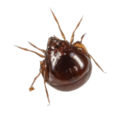Mite
Mites are small arthropods belonging to the class Arachnida and the subclass Acari. The term "mite" refers to the members of several groups in that subclass. Mites are among the most diverse and successful of all the invertebrate groups. They have exploited an incredible array of habitats, and because of their small size, go largely unnoticed. Many live freely in the soil or water, but there are also a large number of species that live as parasites on plants, animals, and some that feed on mold.
Classification[edit]
Mites are invertebrates with two main body parts, eight legs, no antennae and are members of the subclass Acari (also known as Acarina) of the class Arachnida, which also includes spiders and scorpions. They are related to ticks and there are over 48,000 species of mites.
Habitat and behavior[edit]
Mites are found in nearly every habitat in the world. They are tiny, often microscopic animals, and they inhabit the deepest, darkest soils to the loftiest mountain peaks, the broadest deserts, and the wettest tropical rain forests. Some mites are incredibly tough, able to withstand both freezing and boiling temperatures.
Impact on humans[edit]
Mites are tiny, almost invisible, and generally harmless to humans, but they can cause a variety of problems. Some species of mites are human parasites, such as the Scabies mite and the Demodex mites. Other mites are known to be vectors of diseases, such as the mites that transmit Lyme disease.
See also[edit]
|
|
|
Mite[edit]
-
Trombidium holosericeum
-
Varroa destructor
-
Yellow mite (Tydeidae) Lorryia formosa
-
Milbe cf Glaesacarus rhombeus
-
Neobisium sylvaticum
-
Ixodes scapularis
-
Varroa destructor (white background)
-
Rote Samtmilbe Namibia
-
Galumnidae sp
-
Ammotrecha itzaana
-
Acarine anatomy and morphology
-
Harvest mite cycle
Ad. Transform your life with W8MD's Budget GLP-1 injections from $75


W8MD offers a medical weight loss program to lose weight in Philadelphia. Our physician-supervised medical weight loss provides:
- Weight loss injections in NYC (generic and brand names):
- Zepbound / Mounjaro, Wegovy / Ozempic, Saxenda
- Most insurances accepted or discounted self-pay rates. We will obtain insurance prior authorizations if needed.
- Generic GLP1 weight loss injections from $75 for the starting dose.
- Also offer prescription weight loss medications including Phentermine, Qsymia, Diethylpropion, Contrave etc.
NYC weight loss doctor appointmentsNYC weight loss doctor appointments
Start your NYC weight loss journey today at our NYC medical weight loss and Philadelphia medical weight loss clinics.
- Call 718-946-5500 to lose weight in NYC or for medical weight loss in Philadelphia 215-676-2334.
- Tags:NYC medical weight loss, Philadelphia lose weight Zepbound NYC, Budget GLP1 weight loss injections, Wegovy Philadelphia, Wegovy NYC, Philadelphia medical weight loss, Brookly weight loss and Wegovy NYC
|
WikiMD's Wellness Encyclopedia |
| Let Food Be Thy Medicine Medicine Thy Food - Hippocrates |
Medical Disclaimer: WikiMD is not a substitute for professional medical advice. The information on WikiMD is provided as an information resource only, may be incorrect, outdated or misleading, and is not to be used or relied on for any diagnostic or treatment purposes. Please consult your health care provider before making any healthcare decisions or for guidance about a specific medical condition. WikiMD expressly disclaims responsibility, and shall have no liability, for any damages, loss, injury, or liability whatsoever suffered as a result of your reliance on the information contained in this site. By visiting this site you agree to the foregoing terms and conditions, which may from time to time be changed or supplemented by WikiMD. If you do not agree to the foregoing terms and conditions, you should not enter or use this site. See full disclaimer.
Credits:Most images are courtesy of Wikimedia commons, and templates, categories Wikipedia, licensed under CC BY SA or similar.
Translate this page: - East Asian
中文,
日本,
한국어,
South Asian
हिन्दी,
தமிழ்,
తెలుగు,
Urdu,
ಕನ್ನಡ,
Southeast Asian
Indonesian,
Vietnamese,
Thai,
မြန်မာဘာသာ,
বাংলা
European
español,
Deutsch,
français,
Greek,
português do Brasil,
polski,
română,
русский,
Nederlands,
norsk,
svenska,
suomi,
Italian
Middle Eastern & African
عربى,
Turkish,
Persian,
Hebrew,
Afrikaans,
isiZulu,
Kiswahili,
Other
Bulgarian,
Hungarian,
Czech,
Swedish,
മലയാളം,
मराठी,
ਪੰਜਾਬੀ,
ગુજરાતી,
Portuguese,
Ukrainian















